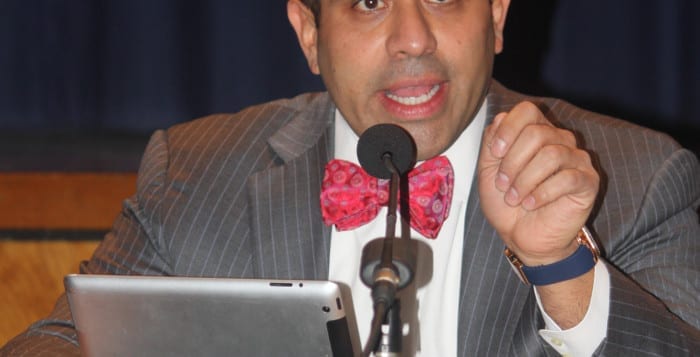Protestors are no longer minding the gap when it comes to the state’s minimum wage.
Protestors flocked to the Huntington Long Island Rail Road station during the evening rush hour on Monday in support of an increase in the state minimum wage.
The group also hit several other North Shore train stations in areas where state senators have not yet committed to supporting New York Gov. Andrew Cuomo’s (D) proposal for a $15-per-hour minimum wage.
“This state thrives when every New Yorker has the opportunity and the ability to succeed,” Cuomo said in a statement in support of his minimum wage hike from $9 per hour. “Yet the truth is that today’s minimum wage still leaves far too many people behind — unacceptably condemning them to a life of poverty even while they work full-time. This year, we are going to change that. We are going to raise the minimum wage to bring economic opportunity back to millions of hardworking New Yorkers and lead the nation in the fight for fair pay.”

Members of the group Bend the Arc: A Jewish Partnership for Justice, organized the protests with hopes of putting pressure on North Shore lawmakers.
“We’re making a splash during rush hour today to remind our state senators that the economic security of millions of New Yorkers is in their hands,” Rachel Ackoff, senior national organizer at Bend the Arc, said in an email. “Our state and country are facing an economic inequality crisis and raising the minimum wage is essential to help countless families get by and strengthen our economy.”
As for why the group chose to protest at train stations, Ackoff said it is a common ground for all walks of life.
“LIRR stations are the central meeting grounds of thousands of workers heading to and from their jobs each day,” she said. “We appreciated the cheers and thumbs up of the folks we encountered.”
Ackoff said many New York workers who are not making the minimum wage are struggling to support families.
“We’re so outraged by the fact that so many parents in our state, who are working full times jobs on the current minimum wage, aren’t even paid enough to provide for their families’ basic needs,” she said. ““It’s time for our state leaders to take action.”
She zeroed in on specific North Shore lawmakers, including state Sens. John Flanagan (R-East Northport), Carl Marcellino (R-Syosset), and Michael Venditto (R-Massapequa).

Marcellino, who presides over parts of Huntington, did not return a call for a comment.
Bend the Arc has several chapters across the country, and this year, they launched #JewsFor15 a campaign to support the fight for $15, by mobilizing Jewish communities across the country to support local and state campaigns to increase the minimum wage. They said they feel not supporting the $15-per-hour minimum wage is a violation of fundamental values as both Jews and Americans.
“By speaking up for the ‘Fight for $15 movement,’ we are honoring the legacy of our Jewish ancestors, many of whom immigrated to the U.S. at the turn of the century, worked in factories, and fought for higher wages and union rights,” Ackoff said.
Eric Schulmiller, of the Reconstructionist Synagogue of the North Shore in Manhasset, echoed the sentiment while speaking at the Hicksville train station.
“I’m here today because striving for social justice is a core part of my identity as a faith leader and a core part of Jewish communal traditions,” he said. “Jews have been engaged in America’s social justice movements for generations and we’re not about stand on the sidelines now, when countless American families are struggling to make ends meet and economic inequality is growing more and more severe.”


















